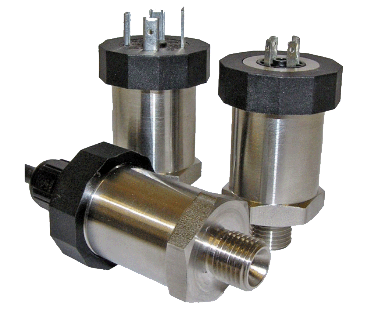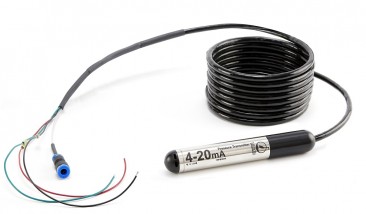A pressure transducer is a device which converts an applied pressure into a measurable electrical signal which is linear and proportional to the applied pressure.
Standard Pressure Units
Within industry there are three major pressure datum’s that you will need to understand for your given application; absolute, differential, and gauge pressure. Each area of the world uses a different unit of measure depending mostly on regionality as well as the magnitude of the measurement. The most common units of measure are Pounds Per Square Inch (PSI) and Bar (B) for higher pressure ranges and Inches of Water Column (“WC) and Pascal (Pa) for lower pressure ranges (for a list of common units and conversions please go to our Conversion Tool).
When the unit of measure and the pressure datum are combined it gives the user a more complete description of what is going on or what is needed in the application. The pressure datum is typically depicted as a suffix to the unit of measure.
Absolute pressure is measured relative to a perfect vacuum. A common unit of measure is pounds per square inch absolute (PSIA).
Differential pressure is the difference in pressure between two points of measurement (measured relative to a reference pressure). This is commonly measured in units of pounds per square inch differential (PSID).
Gauge pressure is measured relative to current atmospheric pressure Common measurement units are pounds per square inch gauge (PSIG – also PSIC for compound or PSIV – Vacuum are also commonly used gauge measurements)
IMP Industrial Pressure Transmitter
Understanding the difference between gauge and absolute pressure is critical for most applications. Remember that gauge pressure is measured relative to current atmospheric pressure (subject to change with changes in the barometric pressure) and that absolute pressure is measured relative to a perfect vacuum. Thus, your application will determine which of these approaches is required.
Also, within the pressure datum known as “gauge pressure” there are three main categories:
Vented to Atmosphere (PSIG)
Sealed (PSIS)
Vacuum (PSIV)
By design, pressure transducers are available to measure gage, absolute or sealed pressure. The most common reference is atmospheric pressure and the units are designated at PSIG. In this case the measuring device is referred to as a Gage Pressure Transducer.
Gage Pressure Transducer – PSIG
Measures pressure referenced to local atmospheric pressure and is vented to the atmosphere. When the pressure port is exposed to the atmosphere, the transducer will indicate 0 PSIG. This occurs because the pressure on both sides of the diaphragm is the same and there is no net output.
Venting is accomplished by means of a small diameter hole located near the transducer’s electrical termination – connector or cable. The vent hole contains a porous, stainless steel disk designed to filter out harmful airborne particles from entering the transducer. Depending on accuracy class, PSIG transducers above certain pressure levels may in fact be sealed. This can be done because the possible measurement errors due to sealing will stay within the accuracy specification of the transducer.
Absolute Pressure Transducer – PSIA
Measures pressure referenced to an absolute vacuum, hermetically sealed at 0 PSIA. When the pressure port is exposed to the atmosphere, the transducer will indicate atmospheric pressure; approximately 14.7 PSIA. This occurs because there is a vacuum on one side of the diaphragm and atmospheric pressure on the other. The net output represents the difference, which is atmospheric pressure.
Depending on accuracy class, PSIA transducers above certain pressure levels may not have an absolute vacuum reference. They can be sealed with atmospheric pressure because the possible measurement errors will stay within the accuracy specification of the transducer.
Sealed Pressure Transducer – PSIS
Measures pressure referenced to the prevailing atmospheric pressure hermetically sealed within the transducer. When the pressure port is exposed to the atmosphere, the transducer will indicate approximately 0 PSIS. This occurs because there is a fixed atmospheric pressure on one side of the diaphragm and the ambient atmospheric pressure on the other side. If they are the same the net output is 0 PSIS. If they are not the same, then the net output will be a reading other than 0 PSIS.
Depending on accuracy class, and design considerations, PSIS transducers below certain pressure levels are not available. Internal pressure changes due to temperature will produce measurement errors that will exceed the accuracy specification of the transducer. If a sealed transducer is required at low pressure levels, then the PSIA version should be used.
Heron 4-20ma vented Pressure Transmitter
Practical Applications
Absolute Measurements
Absolute measurements are generally used in applications where you need a repeatable reference pressure; i.e. in an experiment or in a barometric application. For example if you are looking to replicate a test that was originally completed by a colleague in a different geolocation, you may want to use an absolute sensor to minimize variables in your test. Other applications include weather stations, altimeter calibration equipment, and semiconductor fabs and many more. However, if you want to measure or control a pressure that is based on current conditions a gauge sensor may be best.
Gauge Measurements
Generally, if you want to measure or control a pressure that is influenced by changes in atmospheric pressure. This style sensor is used in any application where you want to overcome the atmospheric conditions to produce a task or pull a vacuum to accomplish another type of task. The applications for gauge pressure sensors are quite vast. Some examples are pump discharge pressure, fire hose discharge pressure, tank level, steam pressure in a commercial boiler and many more.
Differential Pressure Sensors
Remember that Differential pressure is the difference in pressure between two points of measurement. You can measure very low to high pressures in all kinds of different media including liquids, gases, water, refrigerants and air. Thus, if you want to measure the difference in pressure across a filter (see below), you could use a differential pressure transducer to tell you when it was time to change the filter so you can maintain the Indoor Air Quality (IAQ) of your building. Differential applications can be quite varied, some examples are supply and return pressure in a chiller, air flow stations, leak detection systems, pressurised tank level, hospital isolation or protection rooms, and many more.
See our range of pressure sensors here >>
Note: This information was collated from web resources located within the public domain. No liability for the accuracy of this text nor it’s use for any reason whatsoever is accepted by Bell Flow Systems Ltd



